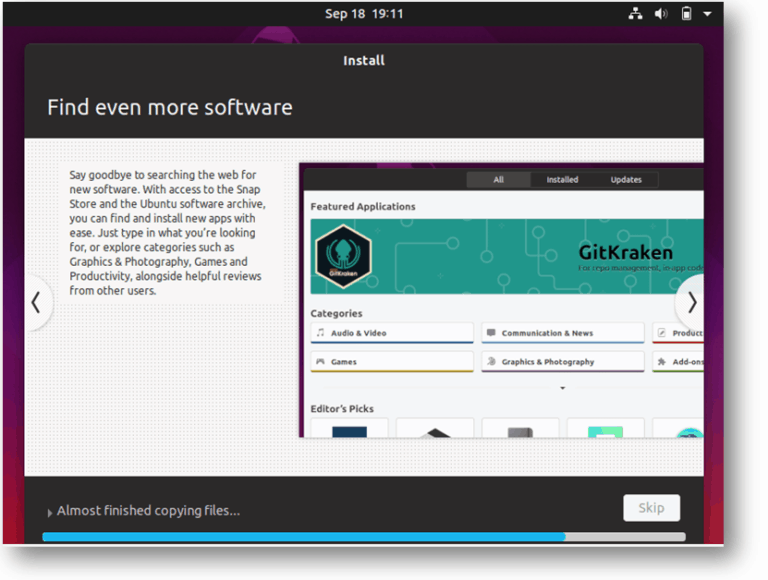
- SETTING UP A UBUNTU VIRTUALMACHINE ON UBUNTU DESKTOP HOW TO
- SETTING UP A UBUNTU VIRTUALMACHINE ON UBUNTU DESKTOP INSTALL
- SETTING UP A UBUNTU VIRTUALMACHINE ON UBUNTU DESKTOP PRO
- SETTING UP A UBUNTU VIRTUALMACHINE ON UBUNTU DESKTOP ISO
- SETTING UP A UBUNTU VIRTUALMACHINE ON UBUNTU DESKTOP DOWNLOAD
SETTING UP A UBUNTU VIRTUALMACHINE ON UBUNTU DESKTOP ISO
Power on the VM, the Ubuntu 20.04 installer should boot from the attached ISO installation image.
SETTING UP A UBUNTU VIRTUALMACHINE ON UBUNTU DESKTOP INSTALL
Once the new virtual machine has been created, you should install Ubuntu 20.04 as a guest operating system on this VM. Click OK to save settings and close this window. You can check and edit other VM settings if needed. Secure boot is not needed for this virtual machine. In the navigation pane, select Security in the Hardware section, and deselect the Enable Secure Boot checkbox. Right-click the Ubuntu Hyper-V VM in Hyper-V Manager and, in the context menu, hit Settings. Open the settings of the Ubuntu Hyper-V virtual machine that you have already created. Check configuration summary, and click Finish to finish the new VM creation.
SETTING UP A UBUNTU VIRTUALMACHINE ON UBUNTU DESKTOP DOWNLOAD
You can download the installation image from the official Ubuntu website. The Ubuntu version I’m going to install is 20.04.2. Click Browse and select the location of the Ubuntu 20.04 ISO installation image. Select Install an operating system from a bootable image file. I select 15 GB for my Ubuntu 20.04 VM used for testing purposes. In my case, the selected directory is E:\VMs\Ubuntu Hyper-V\Virtual Hard Disks\. You should select the location in your directory used to store Hyper-V VMs. Define the location of the virtual disk file. Enter the virtual disk name, for example, Ubuntu Hyper-V.vhdx. If you have not created any virtual switches, you can do it later and edit the VM configuration.Ĭonnect Virtual Hard Disk. Select a virtual switch to which the virtual network adapter of the VM will be connected. If you run other VMs simultaneously with this Linux VM, remember that other VMs also need memory.Ĭonfigure Networking. Don’t assign all the memory of your computer to the VM leave memory for the host operating system. The more memory you assign to the VM, the more convenient the work. Select the checkbox to Use Dynamic Memory for this virtual machine.

I select 4096 MB, which is enough to run Ubuntu without performing heavy tasks. Specify the amount of memory available to the VM. Read more about Hyper-V Generation 1 and Generation 2 VMs.Īssign Memory. It is better to select Generation 2 because more features are available and limits are higher. Hit Next at each step of the wizard to continue. Select the Store the virtual machine in a different location checkbox, and select the folder where you want to store VM files, for example, E:\VMs\. Enter a virtual machine name, for example, Ubuntu Hyper-V. In order to create a new VM in Hyper-V, open Hyper-V Manager, right-click your host machine name and, in the context menu, click New > Virtual Machine.
SETTING UP A UBUNTU VIRTUALMACHINE ON UBUNTU DESKTOP HOW TO
If you don’t have Hyper-V installed on your Windows host, read how to install Hyper-V on Windows 10 and Windows Server 2019.

You have to enable Hyper-V before you can run the Ubuntu VM. The hostname of my Windows 10 host machine is home-pc.
SETTING UP A UBUNTU VIRTUALMACHINE ON UBUNTU DESKTOP PRO
In this blog post, I’m using Windows 10 Pro version 20H2 with Hyper-V installed. Let’s look at how to create and configure an Ubuntu 20.04 VM from scratch in Hyper-V. This blog post explains how to run Ubuntu on Windows by using Hyper-V in the enhanced session mode. One of the most popular Linux distributions now is Ubuntu 20.04 LTS, and users often install this operating system on Hyper-V virtual machines when they cannot install Linux as a host OS and for other reasons. However, if you use Linux as a guest OS on a Hyper-V VM, you have to perform additional configuration because RDP (Remote Desktop Protocol) services are not pre-configured in Linux. If you run Windows as a guest operating system (OS) on Hyper-V, you can easily enable the enhanced mode, because support of Remote Desktop is a built-in feature in Windows. In the enhanced session mode, you can resize the screen of the VM, copy and paste text from a host to guest and vice versa. The enhanced session mode is based on the RDP protocol and allows you to attach host machine resources (such as disk drives, printers, USB devices, and other devices) to a virtual machine.

If you use Hyper-V, you have probably noticed that it is more convenient to manage Hyper-V virtual machines in a Hyper-V Manager by using the enhanced session mode rather than the basic session mode of VM Connect. By Michael Bose Detailed Walkthrough: Install Ubuntu 20.04 on Hyper-V with Enhanced Session


 0 kommentar(er)
0 kommentar(er)
